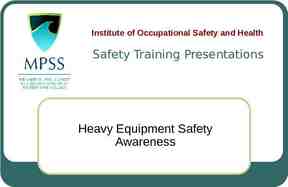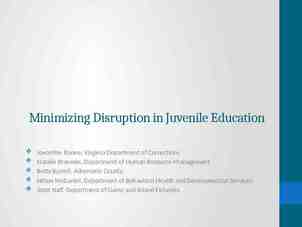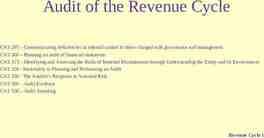Characteristics and Components of Effective Prevention Programming
38 Slides554.20 KB

Characteristics and Components of Effective Prevention Programming Presented By: Kasey Evans, M.S. Assistant Director of the Illinois Higher Education Center Eastern Illinois University

Why this workshop was created Lack of utilization of evidence-based, evidence informed programs Ongoing need to address topics which are void of evidencebased, evidence informed programs Development of “home grown” programs Pressure from administration to “do something,” particularly after crisis Questions from others on how to choose “good programming”

How you may ultimately use this workshop Educate other stakeholders regarding “better” prevention programs over “less desirable” programs Advocacy for why certain programs/strategies are more desirable Develop programs and interventions that are more likely to be effective and impacting Use as a tool when deciding whether to adopt programs and interventions others have developed or are using.

Learning Outcomes Participants will be able to: Explain the differences in levels of prevention Describe interventions that, alone, are unlikely to contribute to change in attitudes, beliefs, values, and behaviors List characteristics and programmatic components of effective prevention programming Better identify programs and interventions that will meet the characteristics and components of effective prevention programming.

When you think “prevention” program, what comes to mind?

When you say “Prevention” do you really mean “Prevention”?

Prevention by Another Name

Is Your Institution Addressing Prevention Through a Socio-Ecological Model Approach?

Elements of Prevention Programs Using a Socio-Ecological Approach Individual Looking at individual knowledge, attitudes, beliefs, values Addressing coping skills, particularly during transitions Interpersonal Bystander interventions Conflict resolution/mediation Partner communication Organizational Addressing social climate in school Addressing perceived and actual social norms within the organization Community Improving relationships and communications between town and gown Community mobilization/coalition strategies Public Policy Required training for those working with youth

Ten Primary Principles of Effective Prevention Interventions and Strategies “At a Glance”

X 12 X X X X 12 X 12 X X X X X X X 12 X X X X X X X X X X Defined Population X 13 X X X X Evidence-Based X X X X X Risk & Protective Factors X X X X X X X Appropriate Timing X X X X X X X X X Relationships X X X X X X X X X X X X X X Developmentally Appropriate X X X X X Outcome Evaluation X Outcome Evaluation X X X X Theory Driven X X X X X 16 Sufficient Dosage X X X X X Varied Teaching Methods/Engaging X X X X X X X X X Comprehensive X X X X X X Well Trained Staff Socio-Culturally Relevant Berkowitz (2000) Bond & Hauf (2004) Borkowski, Akai & Smith (2007) Borkowski, Smith, & Akai. (2006) Bronte-Tinkew et al (2006) Caspe & Lopez (2006) CDC Cuijpers (2002) Durlak (2003) Dusenbur, Falco,et al. (1997) Dusenbury & Falco (1995) Ennet et al. (2003) Kumpfer & Alder (2003) Kumpfer & Alvarado (2003) Mazza (1997) Nation et. al (2003) National Office of Drug Control Policy (2014) NIDA (2003) Rotheram-Borus (2008) Weissberg et. Al (2003) X X X X 9 X X X X X X X X X 9 X X X X X X X X X X 9 7 X X 6 X X X X X 5 4 1

10 Primary Principles of Effective Prevention Interventions and Strategies “At a Glance” Comprehensive Services Varied Teaching Methods Sufficient Dosage Theory Driven Positive Relationships Appropriately Timed Socio-Culturally Relevant Outcome Evaluation Well-Trained Staff Developmentally Appropriate Nation, M., Crusto, C., Wandersman, A., Kumpfer, K. L., Seybolt, D., Morrissey-Kane, E., & Davino, K. (2003). What works in prevention: Principles of Effective Prevention Programs. American Psychologist, 58, 449-456.

Comprehensive Services Definition Strategies should include multiple components and affect multiple settings to address a wide range of risk and protective factors of the target problem. Important Points Effective programs address multiple areas of a person’s life such as health, education, social connections, and social conditions by providing services in a variety of relevant settings. Effective programs offer a wide variety of activities to address the target problem, which usually has multiple risk factors. These activities may include several components such as curriculum-based interventions, media campaigns, systems change, and environmental strategies that can affect economic-social conditions.

Varied Teaching Methods Definition Strategies should include multiple teaching methods, including some type of active, skills-based component. Important Points Methods should focus on the development of skills that enable the participants to avoid problem behaviors Provide hands- on experiences for participants which allow skill practice

Sufficient Dosage Definition Participants need to be exposed to enough of the activity for it to have an effect. Important Points Can be measured by the number of contact hours. Amount needed to produce outcomes is contingent on the participant’s level of risk and the amount deficits. Provide some type of follow up or booster sessions. One time presentations rarely produce behavior change

Theory Driven Definition Prevention strategies should have a scientific justification or logical rationale. Important Points Describe a theory about how problem behaviors develop Describe a theory of how or why the strategy is likely to change behavior Use reverse engineering to prevent behavior problems and promote positive behaviors (logic modeling for program planning)

Positive Relationships Definition Programs should foster strong, stable, positive relationships between participants and others. Important Points Support the development of positive relationships Provide an opportunity for participants to establish a strong relationship with at least one person Mentoring Careful not to depend too heavily on adult relationships focused on case management or therapy

Appropriately Timed Definition Program activities should happen at a time (developmentally) that can have maximal impact in a participant’s life Important Points Focus on the risk factors and/or risk behaviors before the develop Tailored to the intellectual, cognitive, and social development level of participants

Socio-Culturally Relevant Definition Programs should be tailored to fit within cultural beliefs and practices of specific groups as well as local community norms Important Points Careful to tailor the content to make it culturally appropriate and relevant to its participants Making a program socio-culturally relevant means Careful not to adopt a one-size-fits-all approach Include participants in the program planning and implementation

Outcome Evaluation Definition A systematic outcome evaluation is necessary to determine whether a program or strategy worked Important Points Build an evaluation strategy into the implementation of the strategy (process evaluation) Evaluation can be used to provide feedback at several stages Should match the logic model of the program

Well-Trained Staff Definition Programs need to be implemented by staff members who are sensitive, competent, and have received sufficient training, support, and supervision. Follow up (booster) training and technical assistance to staff are critical Important Points Implemented by staff that receive formalized training High rates of turnover, low morale, “buy in” issues

Developmentally Appropriate Definition Generally means to make decisions based on what the individual (s) need developmentally (generalized by age and stage) Important Points Student Develoment Theory Categories Psychosocial. Focuses on long-term issues that tend to occur in sequence and are correlated with chronological age and 'life stages' by accomplishing certain deeds. Cognitive-Structural. how students perceives and rationalize their experiences. Person-Environment. interaction between conceptualizations of the college student and the college environment, looking at behavior as a social function of the person and the environment. Humanistic Existential. concentrate on certain philosophical concepts about human nature: freedom, responsibility, self-actualization and that education and personal growth is encouraged byself-disclosure , self-acceptance and self-awareness. These theories are used extensively in counseling. Student Development Process Models. Student development process models can be divided into abstract and practical. Student Development Theory, University of Texas, Dallas

What Interventions Are We Employing that May Not Be Working?

What We Commonly See Guest Speakers/Lectures/Assemblies (when alone) Self Esteem Days (when alone) Information Tables/Exhibits/Displays Dead Days/Crashed Cars Drunk Driving Simulators Scare Tactics

Think About a Program You Are Currently Using

Comprehensive Does the program include multiple components? Does the program provide activities in more than one setting? Do the activities happen in settings related to the risk and protective factors associated with the problem?

Varied Teaching Methods Does the program include more than one teaching method? Does the strategy include interactive instruction, such as role-play and other techniques for practicing new behaviors? Does the strategy provide hands on learning experiences, rather than just presenting information or other forms of passive instruction?

Sufficient Dosage Does the strategy provide more than one session? Does the strategy provide sessions long enough to present the program content? Does the intensity of the activity match the level of risk/deficits of the participants? Does the strategy include a schedule for follow up or booster sessions?

Theory Driven Does the program provide (or can you identify) a theory of how the problem behaviors develop? Does the program articulate a theory of how and why the intervention is likely to produce change? Bring your model of the problem and model of the solution together to develop a logic model. Based on the model of the problem and the model of the solution, do you believe that the program is likely that the program will produce change?

Appropriate Timing Does the strategy happen before participants develop the problem behavior? Is the strategy timed strategically to have an impact during important developmental milestones related to the problem behavior? Does the activity content seem developmentally (intellectually, cognitively) appropriate for the target population?

Socially/Culturally Relevant Does the strategy appear to be sensitive to the social and cultural realities of the participants? If not, are you capable of making the changes that are needed to make it more appropriate? Is the strategy flexible to deal with special circumstances or individual needs of potential participants? Is it possible to consult some potential participants to help you evaluate and/or modify the strategy?

Outcome Evaluation Is there a plan for evaluating the program? Does the evaluation plan provide feedback prior to the end of the program? Is there a plan for receiving feedback throughout the program development and implementation?

Well-Trained Staff Is there sufficient staff to implement the program? If so, has the staff received sufficient training and supervision and support to implement the program properly? Will efforts be made to encourage stability and high morale in the staff members who will provide the program?

Developmentally Appropriate Does program methods and content align with participant physical abilities? Does program methods and content align with participant cognitive abilities? Does program align with where students are morally? Where they are in transition

Questions?

Contact Information Kasey Evans, M.S. [email protected]

References and Sources Berkowitz, A. D. (2000). Critical Elements of sexual assault prevention and risk reduction programs for men and women. Sexual assault in context: teaching men and women about gender. Cooper, W. O., Lutenbacher, M., Fuccia, K. (2000). Components of effective youth violence prevention programs for 7 to 14 year-olds. Archive of Pediatric and Adolescent Medicine, 154, 1134-1139. Cuijpers, P. (2002). Effective ingredients of school-based drug prevention programs, a systematic review. Addictive Behaviors, (27), 1009-1023. Durlak, J. A., Weissberg, R. P., Pachan, M. (2010). A meta-analysis of after-school programs that seek to promote personal and social skills in children and adolescents. American Journal of Community Psychology. Dusenbury, L., Falco, M. (1997). Characteristics of effective substance abuse prevention programs. ResearchBrief, 1(26). Dusenbury, L., Falco, M., Lake, A., Brannigan, R., Bosworth, K. (1997). Nine critical elements of promising violence prevention programs. Journal of School Health, 67(10), 409-414. Dusenbury, L., Falco, M. (1995). Designing Effective Prevention Programs, How good Science Makes Good Art. Journal of School Health, 65(100), 420-441. Ennett, S. T., Ringwalt, C. L., Thorne, J., Rohrbach, L. A., Vincus, A., Simons-Rudolph, A., Jones, S. (2003). A comparison of current practice in school-based substance useprevention programs with menta-analysis findings. Prevention Science, 4(1), 1-14.

References and Sources Gottfredson, D. C., Wilson, D. B. (2003). Characteristics of effective school-based substance abuse prevention. Prevention Science, 4(1), 27-38. Knox, L. M., Spivak, H. (2005). What health professionals should know: Core competencies for effective practice in youth violence prevention. American Journal of Preventative Medicine, 191-199. Mazza, J. J. (1997). School-based suicide prevention programs: Are they effective? School Psychology Review, 26(3), 382-396. Merell, K. W., Isava, D. M. (2008). How effective Are school bullying intervention programs? School Psychology Quarterly, 23(1), 26-42. Nation, M., Crusto, C., Wandersman, A., Kumpfer, K., Seybolt, D., Davino, E. M., Davono, K. (2003). What works in prevention. American Psychologist, 58(6/7), 449-456. Unknown. (2007). Identifying and selecting evidence-based interventions. Department of Health and Human Services. 1-25. Rotheram-Borus, M. (2008). Common Factors in Effective HIV Prevention Programs. Aids and behavior. Small, S. A., Cooney, S. M., O’Connor, C. (2009). Evidence-Enforced Program Improvement: Using principles of effectiveness to enhance the quality and impact of family-based prevention programs. Family Relations, 58, 1-13. Springer, F., Sale, E., Hermann, J., Sambrano, S., Kasim, R., Nistler, M. (2004). Characteristics of effective substance abuse prevention programs for high-risk youth. The Journal of Primary Prevention, 25(2), 171-194. Wandersman, A., Morrisey, E., Davino, K., Seybolt, D., Crusto, C., Nation, M., Goodman, R., Imm, P. (1998). Comprehensive quality programming and accountability: eight essential strategies for implementing successful prevention programs. The Journal of Primary Prevention, 19(1), 3-29. Wilson, D. B., Gottfredson, D. C., Najaka, S. S. (2001). School-based prevention of problem behaviors: a meta-analysis. Journal of Quantitative Ciminology, 17(3), 247-271.





